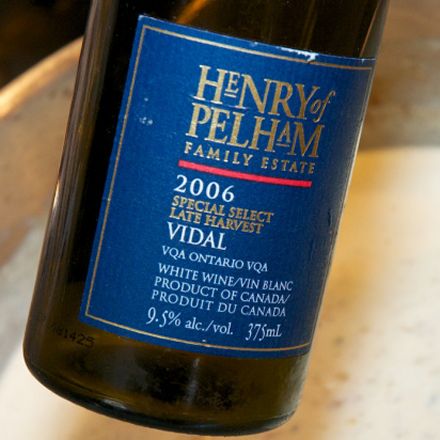Robert Bell's
Wines of Canada
Since 1992
Featured Wines

Late Harvest Wines
Growing grapes for the production of icewine ( Ice wine) is not an easy adventure. To meet the high standard Grapes are left on the vine well into the winter months. The resulting freezing and thawing of the grapes dehydrates the fruit and concentrates the sugars, acids, and extracts in the fruit, thereby intensifying the flavours and adding complexity to the wine. This juice is then fermented very slowly for several months, stopping naturally. Genuine Icewine must be naturally produced; no artificial freezing is permitted.
However the weather does not always co-operate, birds also enjoy the grapes as do the deer. Sometimes it is necessary for the winery to harvest what they can before the conditions arre met to make icewine. This is an opportunity to make a Late Harvest wine.
Late Harvest Wines are usually sweet and therefore are classified as a dessert wine
Some wineries actually decide at the start of the season that they will make Late Harvest wines not icewine.
Late, Select Late and Special Select Late Harvest Wine
1. Each category must be produced entirely from Fresh ripe grapes of which a significant portion has been desiccated under natural conditions. Producing a high sugar concentration.
2. For each category the residual sugar and actual alcohol shall result exclusively from the natural sugar of the grapes
Late Harvest Wine - shall be a wine produced exclusively from fresh grapes that have been natural harvest on a vine after achieving a min 23 ° Brix
Select Late Harvest - enhances to 32° brix
Special Late Harvest Wine - enhances to 32° brix
Ice cider
(also apple icewine or cidre de glace in French is the cider equivalent of ice wine : a fermented beverage made from the frozen juice of apples . There are two main approaches to producing ice cider: cryoconcentration and cryoextraction . Cryoconcentration involves harvesting the fruits late in season and leaving them in fresh storage until late December, when they are pressed and the fresh juice is left to freeze naturally. In January, the concentrated juice begins the process of cold fermentation. Cryoextraction (not the same as the cryoextraction of wine ) is similar to the traditional method used to produce ice wine: apples are left on the trees, at the mercy of the weather, until the end of January. They are picked when the temperature hovers around -8°C to -15°C, and then pressed and left to cold ferment for months.The first claim to commercial ice cider was in 1990 in Dunham , a small town in Québec just north of the Vermont border, by Christian Barthomeuf, a pioneer of Québec's small wine industry . He was Domaine Pinnacle 's, largest producer of ice cider in the world, first cidermaker in the early 2000s.
Some recommendations
Kanazawa Diamond Flower 2011
Henry Of Pelham 2013 Special Select Late Harvest Vidal
Paradise Ranch 2011 Late Harvest Merlot
Whistler 2013 Chardonnay Late Harves
Clos du Soleil 2013 Saturn Late Harvest Sauvignon Blanc
Domaine Labranche 2013 Cidre de Glace / Ice Cider
Domaine Pinnacle 2012 Signature Reserve Speciale
Domaine Pinnacle 2012 Ice Cider
Konzelmann Estate 2013 Special Select Late Harvest Vidal
Peller Estates Niagara-on-the-Lake 2013 Private Reserve Late Harvest Vidal
Domaine Labranche 2013 Cidre de Feu / Fire Cider
return to Featured Wines
please see Robert's Selections
Be a page sponsor
Home | Site Map | Gallery |New |Contact Us | ©2021 Robert A Bell